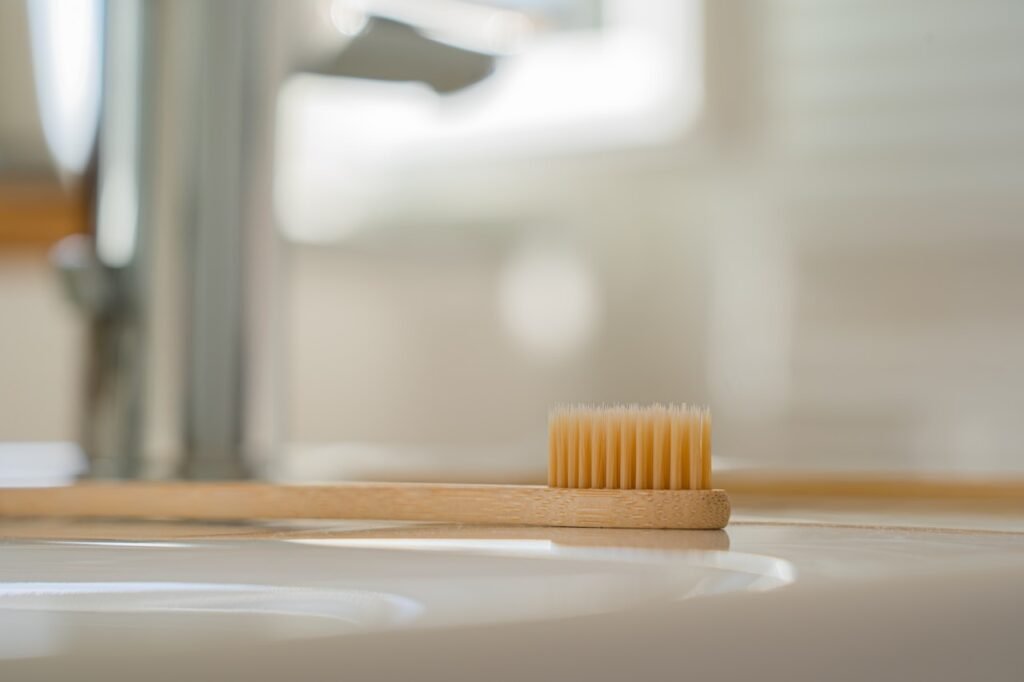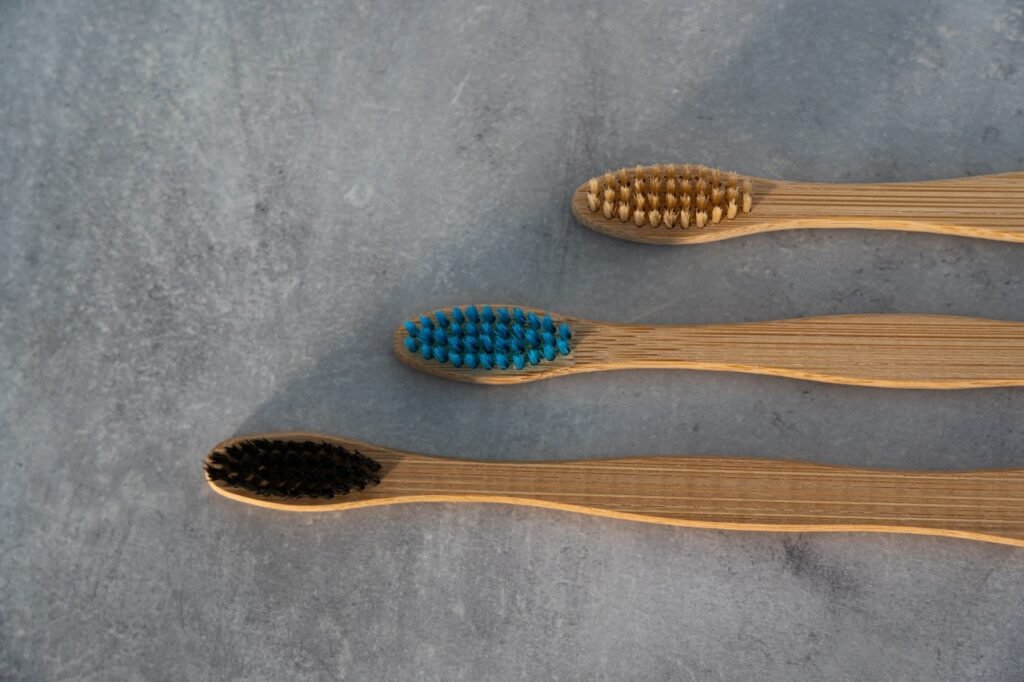Can Bamboo Toothbrushes be Composted?
0Shares
Many individuals are seeking more environmentally friendly substitutes for common items as the world becomes more conscious of the effects of plastic waste on the environment. The toothbrush is one such item; historically, toothbrush handles have been constructed of plastic. Bamboo toothbrushes have been increasingly well-liked recently as an environmentally friendly alternative.
When these toothbrushes end their useful lives, some debate exists about whether they can be composted. In this essay, we’ll examine the issue of bamboo toothbrush compostability and the elements that influence it.
What is Bamboo Toothbrush
A bamboo toothbrush is a particular kind with a handle made of bamboo, a rapidly expanding renewable resource that is safe for the environment. Castor bean oil or biodegradable materials like nylon-4 are typically used to make the bristles on bamboo toothbrushes.
Traditional plastic toothbrushes may be replaced with sustainable and environmentally friendly bamboo toothbrushes. They are also well-recognized for having antibacterial qualities, which make them a fantastic option for keeping your mouth clean. They are often wrapped in eco-friendly materials like cardboard or paper as well. Overall, bamboo toothbrushes are a fantastic choice for people looking for a toothbrushing solution that is more environmentally friendly.
Care Instructions for Your Bamboo Toothbrush

Natural materials like bamboo fare best when stored in a dry environment. Water-collecting enclosed toothbrush containers is not suitable. It’s ideal for storing your toothbrush in a dry, open space like a toothbrush holder.
Please thoroughly wash the toothbrush handle & bristles with water before use, as with any other toothbrush. Compared to plastic toothbrushes, this is particularly crucial for bamboo toothbrushes. After production, some bamboo dust can be left on the toothbrush handle and head. Although this is safe, it must be removed with water. Our soft plant-based bristles can be cleaned and maintained like a regular toothbrush.
Bamboo is a woody natural material that ages over time. With us, the bamboo on the part of your toothbrush that touches your mouth may look lighter and faded. This is typical. You won’t notice a difference while brushing.
Composting Bamboo Toothbrushes
The bristles of a bamboo toothbrush will determine whether or not it may be composted. Most bamboo toothbrushes feature nylon bristles, which should be eliminated before composting since they are not biodegradable. The biodegradable bamboo handle may be thrown in the compost.
The bristles of a bamboo toothbrush should be taken out before composting. Using pliers to remove them or scissors to remove the bristle head can do this. The bamboo handle may be composted once the bristles have been removed. It would help to verify with your local facilities before adding bamboo toothbrushes to your compost pile since not all composting facilities allow them. The bamboo handle will eventually biodegrade in a landfill, so you may also throw it away in your usual garbage as an alternative.
The handle, the bristles, and the metal staples that hold the bristles to the handle make up every toothbrush. All plastic toothbrushes and the manufacturing of toothbrushes both use metal staples. Aluminum staples are the most widely used form of metal staples in all types of toothbrushes and are utilized in Brush with Bamboo toothbrushes. The Brush with Bamboo toothbrush’s bamboo handle is compostable & biodegradable. Although the USDA has certified that the bristles are 100% biobased, they are not biodegradable.
You may recycle these bristles at your neighborhood recycling center, even though they will return to the ground. By removing the bristles from the toothbrush head, you may also remove the metal staples anchoring the bristles to the handle if you’d want to get rid of the aluminum staples from your toothbrush. Like any metal, aluminum will corrode through environmental chemical reactions. Additionally, aluminum is very recyclable. Currently, seventy-five percent of all aluminum produced has been used.
Guide to Dispose of Bamboo Toothbrushes

Changing your toothbrush regularly is crucial since a clean, shining toothbrush keeps your teeth looking bright and smelling minty for much longer. Although we tested our toothbrushes to ensure that they could be used for up to six months, dentists recommend switching out your toothbrushes every two months. Although the bamboo handle is naturally antibacterial, using a bamboo toothbrush or a plastic one both cause the bristles to wear down and bacteria to accumulate.
👉Recycle and Utilize Old Toothbrushes
The maxim “reduce, reuse, recycle” is well known. There are several methods to extend the life and usage of your toothbrush after it has completed its primary task of cleaning your teeth. Sanitize it first by boiling it in hot water for a few minutes, and mark it in some ways so you determine it’s not for use on teeth!
Use it to clean your bathroom. An old toothbrush is a perfect shape and size for all those difficult-to-reach locations, including inside toilets, tiles, behind plug holes, and in the corners of counters.
Upkeep of electrical equipment. An old (dry!) toothbrush works well for cleaning vents on hairdryers, filters on vacuum cleaners, and the spaces between the keys on computer keyboards.
Sanitized cooking utensils. Have you ever been annoyed by the quantity of garlic pulp that sticks to your cheese, garlic crusher, or sieve inside, or by debris that collects there? Keep an old toothbrush by your sink because it makes the best cleaning tool.
Clean the sporting equipment. Have a filthy bike chain or football or rugby boots with muck stuck in the studs? Yes, a used toothbrush works great for cleaning them again.
Establish garden markers. Do you want to avoid using plastic to distinguish between your carrots, potatoes, peppers, and tomatoes? Write the names of each plant on an outdated bamboo toothbrush, then bury it in the ground as a helpful reminder.
👉Take the Bristles Out
While recyclable, our bristles are the only component of a bamboo toothbrush that is not biodegradable (we’re talking about less than a gram of material compared to a whole plastic toothbrush). Our top priority is maintaining oral health and effectively cleaning teeth, and as of now, no biodegradable fiber (aside from pig hair, which we won’t use and has its own set of environmental & ethical implications) performs this function as well or for as long as the nylon-6 bristles used by the industry.
To remove them, use pliers to pull them out. Avoid removing too many bristles at once, and use a soft rolling motion to make it as simple as possible. This will easily and neatly remove the bristles and tiny metal staples.
The bristles may then be placed in your plastic recycling. Still, since they are so tiny and flimsy, we advise placing them inside another plastic object you are recycling first, such as food packaging, a bottle, a carton, or anything item made of plastic.
Consider either maintaining a designated one till it is full or putting the bristles in whatever you discover on your next trash pick if you’ve managed to decrease your plastic usage to the point where you seldom have any acceptable containers to get rid of it in. To hold them all together in an emergency, you may dip them in a glob of glue.
👉Get Rid of the Bamboo Toothbrush Handle
Your toothbrush handle is 100 percent biodegradable, but you must consider how you dispose of it to ensure it decomposes as rapidly as possible. If you have one, you may put it in a home composter, but we advise placing it in your bio-waste bin so that it can be disposed of in a manufacturing composter, where it will decompose in a few weeks. Even if you just put the toothbrush into your regular trash and it ends up in a landfill, it will still decompose after a few years.
Bamboo is a strong and rot-resistant material, but it will ultimately fully deteriorate, making it a great option for toothbrush manufacturing. Whether in or on the soil, hot and wet or cold and dry affects how long it takes to biodegrade.
How long does a bamboo toothbrush take to decompose?
◾️Dumping it in your yard might take up to 10 years for a bamboo toothbrush to completely decompose.
◾️It will take around three years to bury it horizontally in the ground.
◾️Based on content, a home composter should finish in 4-6 months. You may hasten this process by using a hammer or saw to cut the toothbrush into manageable pieces.
◾️A toothbrush should decompose in a few weeks in an industrial composter since they are considerably hotter and much more active than any home composter.
How to Make a Bamboo Toothbrush

Are you seeking a more sustainable toothbrush? Bamboo is the only option! Toothbrushes may be made from bamboo, a sustainable material that can be utilized to manufacture various goods.
How to create a bamboo toothbrush is shown below:
1. Begin with a bamboo piece around the size of a typical toothbrush. To shape the bamboo into the required form, use a sharp knife.
2. To make the bamboo’s edges smoother, sand them down.
3. Near the top & bottom of the brush’s handle, drill a few tiny holes. Later, the bristles will be attached using these holes.
4. Cut a piece of recycled plastic from an old toothbrush and place it in your container. Use this plastic, which has been melted, to patch up the bamboo brush handle’s drilled holes. When the bristles are applied later, they will be firmly in place.
5. Use cotton to secure the brush’s bristles with natural fiber yarn or thread. In the absence of twine or thread, you may use dental floss.
Frequently Asked Questions
How long does it take bamboo to decompose?
If you ask how long bamboo takes to break down, the answer is three to four years. Because bamboo is such a strong material, it takes some time to decompose completely. When it does begin to deteriorate, however, it does so quite swiftly.
Can bamboo brushes be composted?
Unlike nylon toothbrushes and synthetic, manufactured plastic, bamboo is a natural material obtained directly from the bamboo plant. It is 100% biodegradable, plant-based, and quickly expanding. As a result, it is now the sustainable material of choice for many different products, including toothbrushes.
Can you recycle bamboo toothbrushes?
Plastic toothbrushes can’t be recycled or composted after use, but bamboo toothbrushes can!
How can bamboo toothbrush bristles be recycled?
If put in a bigger recyclable container, the bristles may be recycled into plastics: Bristles alone are too tiny to be recycled with plastic. However, they can be recycled completely if you put them in a bigger recyclable container, like a yogurt pot or plastic milk bottle.
Why are toothbrushes made of bamboo sustainable?
Because bamboo is a natural, fully biodegradable, and thus a sustainable and renewable resource, it is an eco-friendly alternative to plastic toothbrushes. We can avoid losing out soon since it is one of the global plants with the quickest growth rates.
Final Thoughts
Bamboo toothbrushes are a great replacement for conventional plastic toothbrushes that may take hundreds of years to degrade since they can be composted. Bamboo toothbrushes may decompose in a few months if disposed of correctly, returning important nutrients to the earth. It’s crucial to remember that not all bamboo toothbrushes are equal and that some may include packaging or synthetic bristles that cannot be composted. If you want to be sure your bamboo toothbrush can be composted, it’s important to read the packaging carefully and adhere to the manufacturer’s recommendations. Utilizing compostable bamboo toothbrushes allows us to lessen our environmental impact and move closer to a sustainable future. Do you want to know how to clean bamboo sushi mat? Click Here!
0Shares
